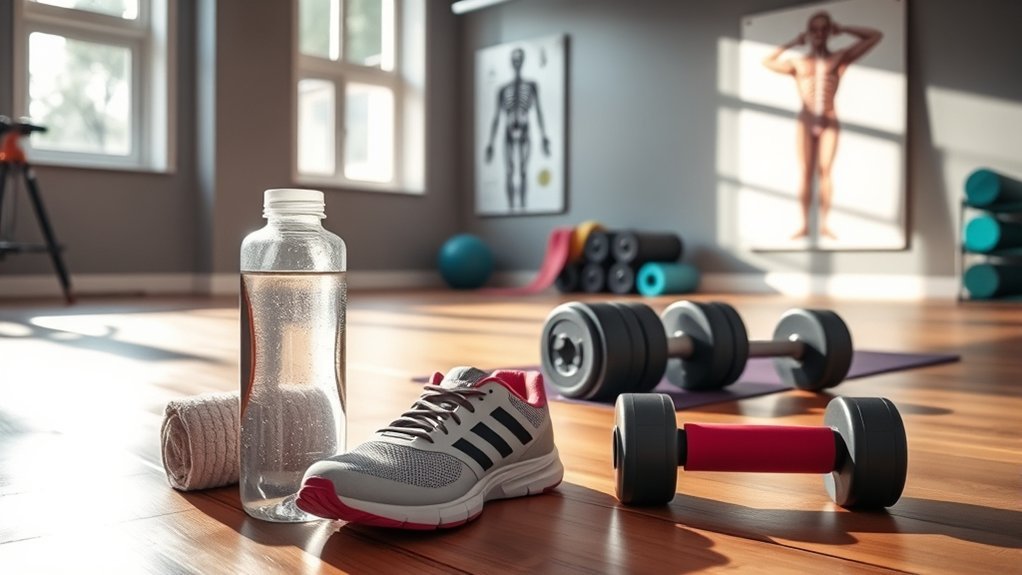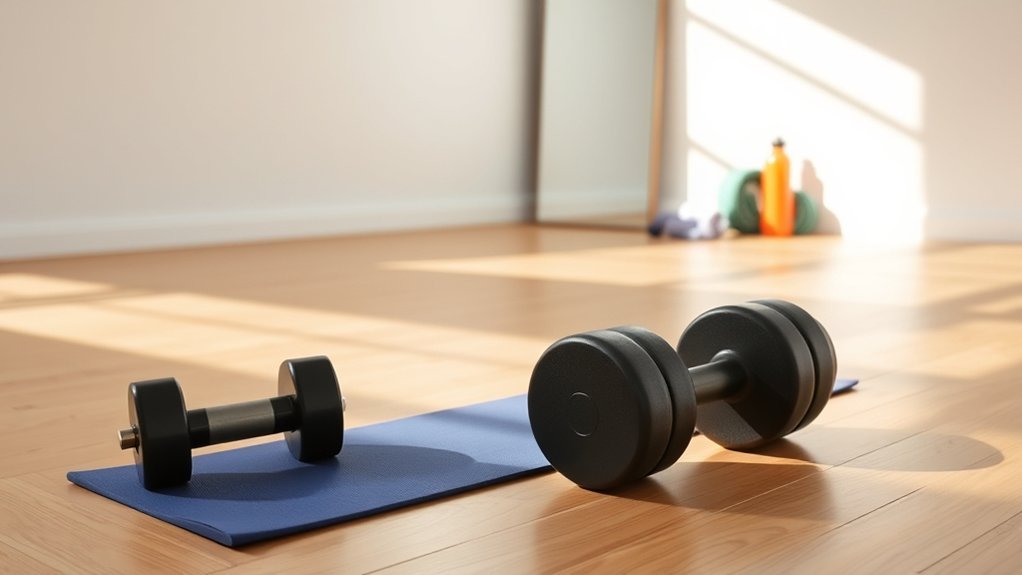When it comes to exercise, you probably have a lot of questions. How much do you really need each week? What types of workouts should you prioritize? Understanding the guidelines can help you make informed choices. Plus, knowing how to prevent injuries and stay motivated is essential for long-term success. Let’s explore these common queries to help you create a sustainable fitness routine that works for you.
How Much Exercise Do I Need Each Week?

How much exercise do you really need each week to stay healthy? The general guideline suggests that adults should aim for at least 150 minutes of moderate-intensity aerobic activity or 75 minutes of vigorous-intensity activity per week. This translates to about 30 minutes a day, five times a week.
Alongside aerobic exercises, it’s important to include muscle-strengthening activities on two or more days weekly. Research shows that meeting these benchmarks can greatly reduce your risk of chronic diseases, improve mental health, and boost overall well-being.
What Types of Exercise Should I Focus On?

While you might be enthusiastic to plunge into any form of exercise, focusing on a well-rounded routine is vital for maximizing your health benefits.
Aim to include three main types of exercise: aerobic, strength training, and flexibility work. Aerobic exercises, like running or cycling, boost your cardiovascular health and endurance. Strength training, using weights or resistance bands, builds muscle and bone density, important as you age.
Don’t neglect flexibility exercises, such as yoga or stretching, which improve your range of motion and prevent stiffness. Incorporating a mix of these activities not only keeps your workouts interesting but also guarantees you’re addressing all aspects of fitness.
How Can I Prevent Injuries While Exercising?

To keep injuries at bay while exercising, it’s essential to start with proper warm-up techniques and choose the right gear.
Warming up increases blood flow to your muscles and prepares your body for more intense activity.
Additionally, wearing appropriate footwear and clothing can greatly reduce the risk of strain and injury.
Proper Warm-Up Techniques
Before diving into your workout, incorporating proper warm-up techniques is essential for preventing injuries and optimizing performance. A good warm-up increases blood flow, enhances flexibility, and prepares your muscles for activity. Here are some effective warm-up strategies:
| Warm-Up Activity | Duration | Purpose |
|---|---|---|
| Dynamic Stretches | 5-10 min | Increase mobility |
| Light Cardio | 5 min | Elevate heart rate |
| Joint Rotations | 3 min | Improve flexibility |
| Sport-Specific Movements | 5 min | Prepare for workout |
| Cool Down | 5 min | Aid recovery |
Appropriate Gear Selection
Selecting the right gear is vital for minimizing injury risk during exercise, as improper equipment can lead to discomfort and strain.
Verify your shoes fit well and provide adequate support for your specific activity—running shoes differ from those designed for weightlifting. Wearing moisture-wicking clothing can help regulate your body temperature and prevent chafing.
If you’re using equipment like weights, confirm they’re the appropriate size and weight for your fitness level. Additionally, consider protective gear such as knee pads or wrist supports, especially in high-impact activities.
Always check for wear and tear on your gear, replacing items when necessary. Proper gear not only enhances performance but also plays a significant role in injury prevention.
Prioritize your safety!
Is It Necessary to Warm Up and Cool Down?
Why is it often emphasized that warming up and cooling down are essential parts of any exercise routine?
Warming up prepares your body for the physical demands ahead, increasing your heart rate and circulation to muscles. This helps reduce the risk of injury. Simple movements like dynamic stretching or light cardio can enhance flexibility and performance.
Cooling down plays an important role too. It helps your heart rate gradually return to normal, preventing dizziness or fainting. Incorporating static stretches post-workout can improve flexibility and muscle recovery.
Research shows that athletes who warm up and cool down experience fewer injuries and better performance.
How Do I Stay Motivated to Stick to My Routine?
Staying motivated to stick to your exercise routine can be challenging, especially as the initial excitement fades. To keep your enthusiasm alive, set specific, achievable goals. Break larger objectives into smaller milestones to celebrate progress regularly.
Variety is key; mix up your workouts to prevent boredom and engage different muscle groups. Additionally, find a workout buddy or join a class for social support and accountability. Tracking your workouts can also boost motivation, as seeing your improvements reinforces your commitment.
Remember to reward yourself for sticking to your routine, whether it’s with new workout gear or a relaxing day off. Finally, focus on how great exercise makes you feel, both physically and mentally, to maintain a positive mindset toward your fitness journey.
What Should I Do If I Miss a Workout?
Missing a workout can feel disheartening, but it doesn’t have to derail your entire fitness journey. First, acknowledge that everyone misses workouts—it’s completely normal. Instead of dwelling on it, focus on what you can control.
If you can, reschedule the missed session for another day or integrate it into your upcoming workouts. Consider a shorter, high-intensity routine to make up for lost time. Stay active throughout the day; take a walk, do bodyweight exercises, or stretch.
It’s essential to maintain your mindset—don’t let guilt creep in. Remember, consistency over time matters more than any single workout.
Finally, reflect on why you missed the session and adjust your schedule to minimize future conflicts. Keep moving forward!
How Can I Track My Progress Effectively?
Tracking your progress is essential for staying motivated and achieving your fitness goals.
You can use fitness apps to monitor your workouts and stats, or keep a journal to jot down your thoughts and improvements.
Both methods offer clear insights into your journey and help you adjust your routine as needed.
Use Fitness Apps
While many people set fitness goals, effectively monitoring your progress is essential to achieving them, and fitness apps can be a game-changer in this regard. These apps offer features that allow you to log workouts, track nutrition, and analyze performance trends over time. To maximize their effectiveness, consider these features:
| Feature | Benefit | Example Apps |
|---|---|---|
| Activity Tracker | Logs workouts and steps | MyFitnessPal, Strava |
| Nutrition Log | Monitors food intake | Lose It!, Cronometer |
| Goal Setting | Sets achievable targets | Fitbit, Nike Training |
| Progress Reports | Visualizes data trends | MapMyRun, Apple Health |
Keep a Journal
Keeping a journal can greatly enhance your ability to track progress and stay motivated on your fitness journey. By writing down your workouts, meals, and feelings, you create a personal record of your achievements and challenges.
This practice promotes accountability, helping you identify patterns in your behavior and adjust accordingly. Regularly reviewing your entries can reveal trends in your performance, showing what works for you and what doesn’t.
Research indicates that people who track their progress are more likely to reach their fitness goals. To get started, set aside a few minutes each day to jot down details.
You’ll not only celebrate your wins but also learn from setbacks, keeping you engaged and focused on your long-term objectives.
Frequently Asked Questions
Can I Exercise if I Have a Chronic Health Condition?
Yes, you can exercise with a chronic health condition, but it’s essential to consult your healthcare provider first. They’ll help you tailor a safe and effective routine that suits your specific needs and limitations.
What Should I Eat Before and After Exercising?
Eat a balanced meal with carbs and protein about 2-3 hours before exercising. Afterward, refuel with protein-rich foods and healthy carbs within 30 minutes to help your body recover and rebuild muscle effectively.
How Can I Incorporate Exercise Into a Busy Schedule?
You can incorporate exercise into a busy schedule by scheduling short workouts. For example, Sarah fits in 20-minute HIIT sessions during her lunch break, boosting her energy and productivity while staying committed to fitness.
Is It Safe to Exercise During Pregnancy?
Yes, it’s generally safe to exercise during pregnancy, provided you’re cleared by your healthcare provider. Engage in moderate activities like walking or swimming, but listen to your body and avoid any exercises that cause discomfort.
What Are the Benefits of Exercising Outdoors Versus Indoors?
Exercising outdoors boosts your mood with fresh air and sunlight, while indoor workouts can feel dull. Nature enhances your experience, providing mental benefits and variety, making it easier to stick with your fitness routine.
Conclusion
Sticking to your exercise routine can be as rewarding as planting a seed and watching it grow. By following the guidelines for frequency, intensity, and variety, you’ll cultivate a healthier lifestyle. Remember to listen to your body, warm up properly, and stay motivated by tracking your progress. If you miss a workout, don’t sweat it—just jump back in. Every step you take brings you closer to your fitness goals, so keep pushing forward!
